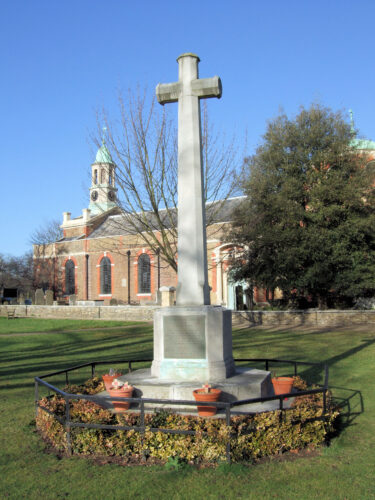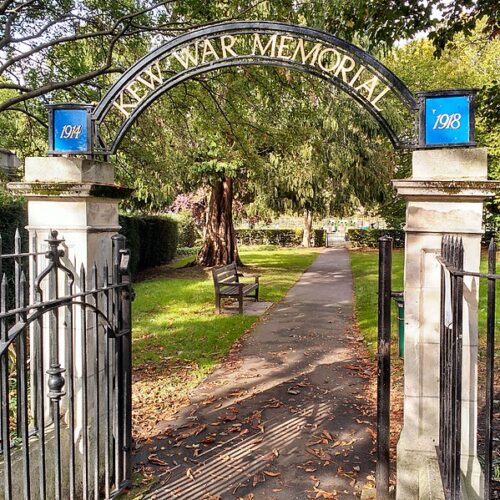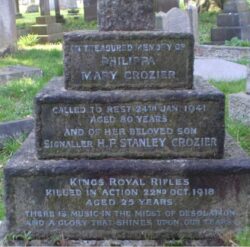Kew’s war memorials
by Simon Fowler
There is a war memorial close to St Anne’s Church on Kew Green. In fact there are three – arguably four – war memorials in Kew for the fallen men from the area.
At the end of the First World War there was a nationwide move to commemorate those who had not returned from the trenches. Each community marked the deaths of local men as they saw fit.

Committees of local dignitaries debated the best way to mark the fallen. Memorials were the most common suggestions, but there many other imaginative schemes. Most had to be abandoned or curtailed because it was increasingly hard to raise money as economic depression gripped the country.
In Kew, unusually, there was no difficulty in raising the funds. By June 1921 public appeals had raised £1700, of which £350 was earmarked for a memorial on Kew Green. The designer was a young local sculptor, Edgar Allan Howes. Originally it was to have been sited roughly where the cricket pavilion is now, but the Office of Works, on behalf of the Crown who own the Green, objected, which is why it is rather hidden away to the south of the St Anne’s church.
It was dedicated by Field Marshal Sir William Robertson on 25 June 1921 in front of a crowd including the mayor, local bigwigs as well as children from King’s School and the local Boy Scout troop. The local papers noted that the ceremony was marked by “brevity and simplicity”.
A few weeks earlier, a memorial screen inside St Anne’s listing ninety men from Kew who had lost their lives in the war was dedicated by General Sir Frederick Maurice. It was painted by Henry Williams, who lived in The Avenue, at no charge to the church.

The remainder of the funds was spent on converting Westerly Ware into a recreation ground, with tennis courts, a playground and other facilities. Before the war the area had been little more than an unkempt field, where children used to play, much to the annoyance of their elders. There never seems to have been a formal opening. Splendid memorial gates were erected in about 1927 and were restored fairly recently.
There were then two parishes in Kew: St Anne’s, for the area between the Green and the station, and St Luke’s, which covered the more working-class district towards Richmond. St Luke’s was a much poorer parish than St Anne’s. Here the funds stretched only to commissioning a solid oak screen and a memorial board listing a hundred local casualties. They were designed by an eminent Scottish architect, Sir Robert Lorimer, and way dedicated in a low key ceremony by a former vicar of the parish.
This article was originally published in Twickenham and Richmond Tribune on 1 October 2022.
At the going down of the sun
by Simon Fowler
Had things been different in 2020 the nation would be commemorating the centenary of the unveiling of the Cenotaph in Whitehall and the dedication of the Tomb of the Unknown Warrior in Westminster Abbey by King George V on Armistice Day, 11 November 1920. And smaller crowds would have gathered around the civic memorials in Twickenham and Richmond to remember local men and women who had fought the good fight.
The Richmond area has a surprisingly large number of memorials to the dead of the two world wars, reflecting the sacrifices made by local men and those from afar who died in local hospitals while recovering from their wounds. Some are imposing, such as the memorial to the Men of Twickenham in Radnor Gardens and the cenotaph for the men who died at the South African Hospital in Richmond Park between 1915 and 1919. But many are simple plaques in churches and chapels. And a range of plaques at the former NHS Healthcare Village in Evelyn Road, Richmond include one to “The Milkmen of the Thames Valley”.
The memorials did not always take the traditional form. The Royal Star and Garter Home for badly wounded veterans at the top of Richmond Hill was designated as the British women’s memorial to the men who had not returned. Teddington has a memorial hospital and Kew a memorial park.
Almost all local cemeteries have one or more distinctive Commonwealth War Graves gravestones marking the burial place of a serviceman or, particularly for the Second World War, RAF aircrew who failed to return from raids over Europe.
In Twickenham’s Oak Lane Cemetery there is a single grave for Corporal H J Harrison, Army Service Corps, who died in November 1915. It is unclear why he lies here, perhaps Corporal Harrison passed away while on home leave.
Even if the war dead now lie in the fine Commonwealth War Graves Commission cemeteries along the old Western Front they are also often remembered on the graves of their parents. For example, my great-uncle Stanley Crozier, who was killed during the last few weeks of the Great War and is buried in Belgium, is also memorialised on the gravestone of his mother, who lies in Teddington Cemetery.
Simon’s piece was first published in Twickenham and Richmond Tribune on 7 November 2020.
